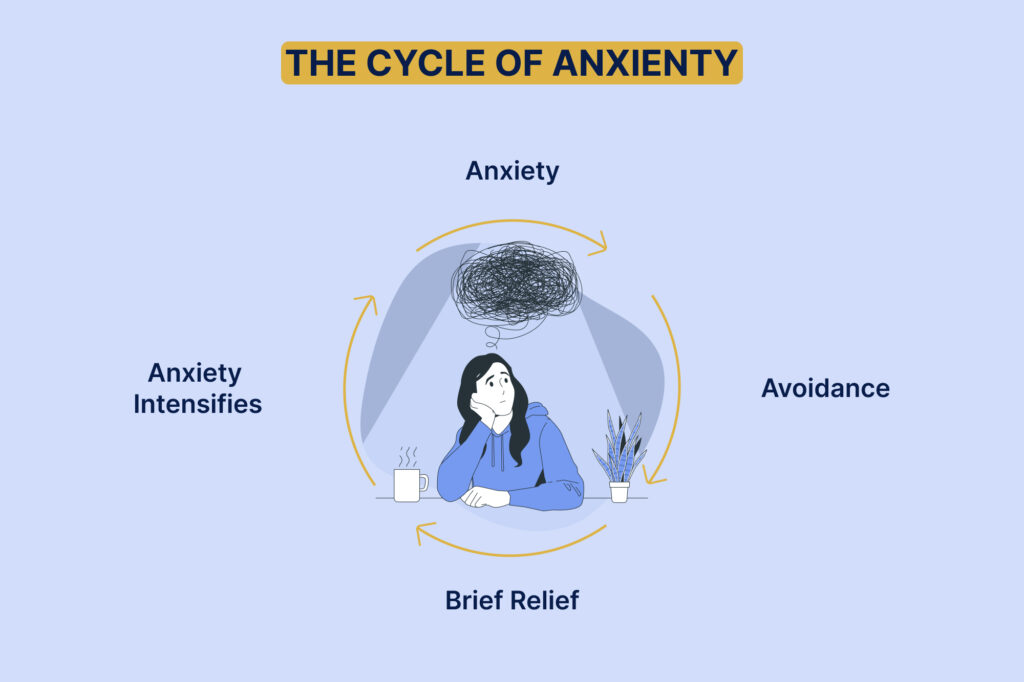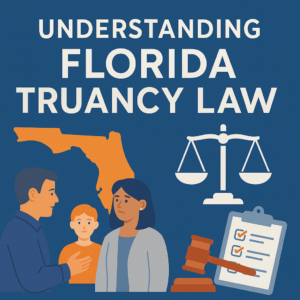Anxiety can turn everyday tasks into daunting challenges. From answering the phone to attending social gatherings, individuals grappling with anxiety often find themselves caught in a cycle of fear and avoidance. This avoidance only serves to reinforce anxiety, making it even more difficult to confront fears in the future.
Understanding the Anxiety/Avoidance Cycle
The Anxiety/Avoidance Cycle is a self-reinforcing pattern of thoughts, emotions, and behaviors that can exacerbate anxiety symptoms and perpetuate distress. It typically unfolds in the following sequence:
- Anxiety Triggers: The cycle begins with the identification of specific triggers or situations that evoke feelings of fear, worry, or unease. These triggers can vary widely among individuals and may include social situations, performance tasks, uncertainty, or perceived threats to safety.
- Anxiety Response: In response to these triggers, individuals experience heightened anxiety symptoms, such as rapid heartbeat, shortness of breath, sweating, trembling, or racing thoughts. These physiological and psychological responses signal a perceived threat, activating the body’s stress response system.
- Avoidance Behaviors: To cope with the discomfort and distress caused by anxiety, individuals may engage in avoidance behaviors. These behaviors involve actively avoiding or escaping from anxiety-provoking situations, people, or activities in an attempt to reduce or eliminate anxiety symptoms temporarily.
- Temporary Relief: Avoidance behaviors may provide temporary relief from anxiety by removing the individual from the perceived threat or reducing their exposure to triggering stimuli. However, this relief is short-lived and often comes at the cost of reinforcing the belief that the feared situation is dangerous or intolerable.
- Cycle Reinforcement: Over time, the Anxiety/Avoidance Cycle becomes self-reinforcing, as avoidance behaviors reinforce the belief that the feared situation is dangerous and increase anxiety in similar future situations. This leads to a cycle of escalating anxiety and avoidance, making it increasingly difficult for individuals to confront their fears and break free from the cycle.
Breaking the Cycle with Exposure Therapy

Exposure therapy is a highly effective treatment approach for breaking the Anxiety/Avoidance Cycle and overcoming anxiety disorders. It involves gradually exposing individuals to feared situations or stimuli in a controlled and systematic manner, allowing them to confront their fears in a safe and supportive environment. Through repeated exposure and response prevention, individuals learn to tolerate and habituate to their anxiety triggers, reducing fear and avoidance over time.
Cognitive Restructuring and Behavioral Activation
In addition to exposure therapy, cognitive restructuring and behavioral activation techniques are also used to disrupt the Anxiety/Avoidance Cycle. Cognitive restructuring involves identifying and challenging irrational or distorted thoughts and beliefs about anxiety triggers, helping individuals develop more adaptive ways of thinking. Behavioral activation focuses on increasing engagement in rewarding and meaningful activities, even in the presence of anxiety, to counteract avoidance behaviors and promote positive experiences.
By understanding the Anxiety/Avoidance Cycle and implementing evidence-based treatments such as exposure therapy, cognitive restructuring, and behavioral activation, individuals can learn to confront their fears, challenge their beliefs, and break free from the cycle of anxiety and avoidance. With the support of skilled therapists and a commitment to treatment, individuals can reclaim control over their lives and experience greater freedom, resilience, and well-being.
Exposure Therapy
Exposure therapy is a cornerstone of cognitive-behavioral therapy (CBT) and is widely regarded as one of the most effective treatments for anxiety disorders. It involves systematically exposing individuals to feared situations, objects, or thoughts in a controlled and gradual manner, allowing them to confront their fears in a safe and supportive environment.
Components of Exposure Therapy:
- Hierarchy Development: The therapist collaborates with the individual to create an anxiety hierarchy, ranking feared situations or stimuli from least to most anxiety-provoking. This hierarchy serves as a roadmap for exposure exercises, starting with less challenging scenarios and progressing to more difficult ones.
- Exposure Exercises: The individual is exposed to anxiety-provoking stimuli or situations in a controlled and systematic manner, either in vivo (real-life) or imaginal (imagined) settings. Exposure exercises may involve direct confrontation with feared stimuli, such as public speaking or exposure to specific phobias, or may focus on confronting feared thoughts or sensations.
- Response Prevention: During exposure exercises, individuals are encouraged to resist the urge to engage in avoidance behaviors or safety behaviors designed to reduce anxiety. By confronting their fears without engaging in avoidance, individuals learn that anxiety is tolerable and diminishes over time, leading to habituation and reduced fear responses.
- Cognitive Restructuring: Throughout exposure therapy, individuals may also engage in cognitive restructuring techniques to challenge irrational thoughts and beliefs about their fears. By identifying and challenging cognitive distortions, individuals can develop more adaptive ways of thinking and reduce anxiety-related symptoms.
Effectiveness of Exposure Therapy:
Research has consistently demonstrated the effectiveness of exposure therapy in treating various anxiety disorders, including phobias, panic disorder, social anxiety disorder, obsessive-compulsive disorder (OCD), and post-traumatic stress disorder (PTSD). Exposure therapy has been shown to produce significant reductions in anxiety symptoms, improve overall functioning, and enhance quality of life for individuals struggling with anxiety disorders.
Mindfulness-Based Interventions
Mindfulness-based interventions are therapeutic approaches that incorporate mindfulness principles and practices to promote awareness, acceptance, and non-judgmental observation of thoughts, emotions, and sensations. These interventions draw from mindfulness-based stress reduction (MBSR), mindfulness-based cognitive therapy (MBCT), and other mindfulness-based approaches developed from Eastern contemplative traditions.
Key Components of Mindfulness-Based Interventions:
- Mindfulness Meditation: Individuals are guided through mindfulness meditation practices that involve focused attention on the present moment, such as observing the breath, body scan exercises, or mindful movement (e.g., yoga). These practices cultivate present-moment awareness and help individuals develop a non-reactive stance towards their thoughts and emotions.
- Acceptance and Non-Judgment: Mindfulness-based interventions emphasize the cultivation of acceptance and non-judgment towards one’s experiences, including difficult thoughts, emotions, and sensations. By adopting an attitude of curiosity and openness, individuals learn to observe their experiences without attaching value judgments or trying to change them.
- Mindful Coping Skills: Individuals are taught practical coping skills and strategies rooted in mindfulness principles to manage stress, anxiety, and other challenging emotions. These skills may include mindful breathing exercises, body scan practices, and grounding techniques to anchor oneself in the present moment during moments of distress.
Benefits of Mindfulness-Based Interventions:
Research has shown that mindfulness-based interventions are effective in reducing symptoms of anxiety, depression, and stress, as well as improving overall well-being and quality of life. These interventions have been found to enhance emotional regulation, increase resilience to stress, and promote psychological flexibility, allowing individuals to respond more effectively to life’s challenges.
Integration of Exposure Therapy and Mindfulness-Based Interventions:
While exposure therapy and mindfulness-based interventions are distinct therapeutic approaches, they can complement each other effectively in the treatment of anxiety disorders. Exposure therapy helps individuals confront their fears directly and build tolerance to anxiety-provoking stimuli, while mindfulness-based interventions provide tools and skills for managing anxiety-related symptoms and promoting emotional regulation. By integrating these approaches, therapists can offer a comprehensive treatment approach that addresses both the symptoms and underlying mechanisms of anxiety disorders, leading to lasting improvements in well-being and functioning for individuals struggling with anxiety.
Conclusion
The anxiety/avoidance cycle can feel like an insurmountable obstacle, trapping individuals in a cycle of fear and avoidance. However, with the right support and resources, it is possible to break free from its grip and reclaim control over one’s life.
Through evidence-based therapies, compassionate support, and personalized treatment plans, we empower our clients to confront their fears, challenge their beliefs, and live more confidently and authentically. Our team of experienced therapists specializes in evidence-based treatments such as exposure therapy, cognitive-behavioral therapy (CBT), and mindfulness-based interventions, providing comprehensive support tailored to each individual’s unique needs and goals.







